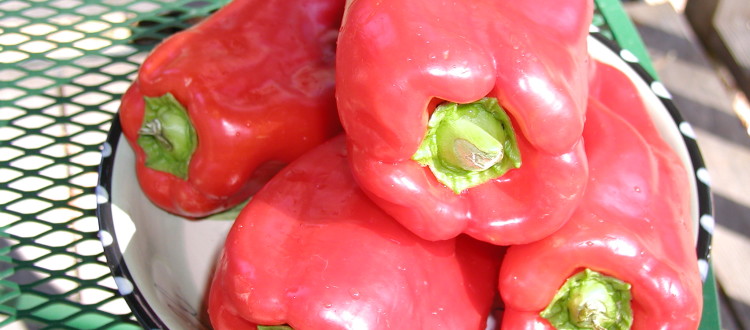Peppers
Sweet Peppers describes a cultivar group within the family, Capsicum annuum, and come in a wide variety of shapes and colors, including, yellow, red, green, purple, even brown. Native to North America, Christopher Columbus is credited with bringing pepper seeds back to Europe where they spread across Europe and into Asia.
Sweet peppers are the only member of the Capsicum family that do not produce capsaicin, a lipophilic chemical that produces a strong burning sensation when it comes into contact with mucous membranes (your mouth and tongue).
Sweet peppers get sweeter as they ripen, and the popular green “bell pepper” actually turns red when it ripens. Green bell peppers are slightly pungent, and less sweet than a fully ripened red bell pepper. Peppers are rich in vitamin C, which continues to increase as it ripens.
How to Plant
Sweet peppers like warm soil and full sun, and their planting site should be rich in organic material such as seasoned compost. They are sensitive to over-watering but don’t let plants dry out. In some gardens pepper plants only require watering 2-3 days per week, while others require daily drenches, depending on temperatures and general exposure. Peppers need between 12 and 48 inches spacing between them, depending on the variety. Pepper plants can produce up to 30 peppers per plant, so staking the plant to keep it upright is a must.
Mulching the area around the base of the plant will help hold in moisture as well as reduce the emergence of weeds.
Fertilizing
Pepper plants respond well to rich fertilizers such as an 8-4-4, or a product labeled “vegetable fertilizer.” Be sure to read and follow the instructions on whatever fertilizer you choose so avoid over-fertilizing.
Harvesting
Peppers will begin to darken slightly when ripe. Use sharp garden shears or scissors to cut the fruit away from the plant. Pulling the pepper to remove it can damage the branch or entire plant. Some papers will continue to change colors for several days after harvesting. Wash all harvested fruit and dry before storing in the refrigerator.
As colder weather approaches, some peppers may still be on the plant. If immature, they’ll taste bitter and are best left in the compost pile.
Recommendations for Use
Remove and discard the seed bunch inside the pepper as well as the “ribs,” as they taste bitter. Peppers can be enjoyed raw in salads, and are also good in stir fried dishes. If you have an overabundance of peppers, try drying them.
To dry peppers, cut into half inch strips and steam for ten minutes, then transfer to a baking sheet in a warm (140°F) oven. Stir occasionally and remove once the pepper pieces become brittle. Store cool peppers in sealed containers.
Peppers
Edit Sweet Peppers in the below Page Builder Section.

